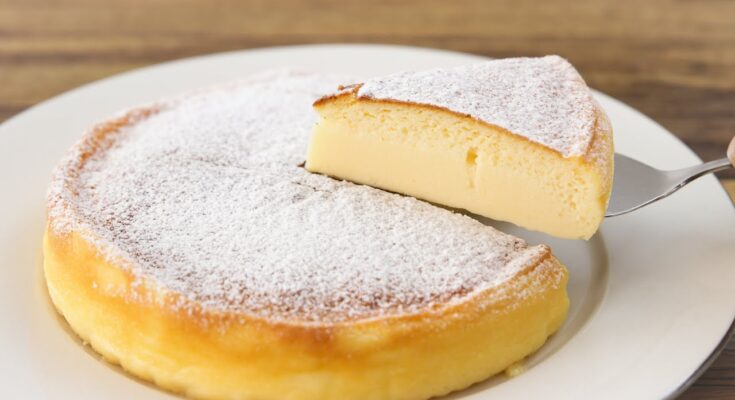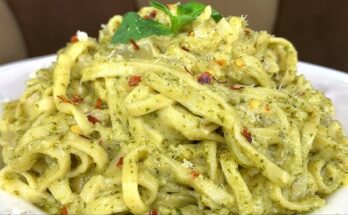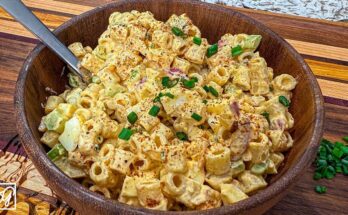Baked Cheesecake Recipe: There’s something absolutely divine about sinking your fork into a creamy, smooth, rich slice of baked cheesecake.
It’s classic, indulgent, and always a crowd-pleaser. Whether you’re making it for a celebration, a holiday, or just to satisfy a craving, a homemade baked cheesecake will never disappoint.
In this guide, we’ll walk you through every step of making the perfect cheesecake from scratch—no fancy ingredients or techniques, just tried-and-true methods that anyone can master.
Introduction to Baked Cheesecake
Cheesecake has been around for centuries, but the baked version we know and love today really gained popularity in the 20th century. Unlike no-bake cheesecakes that rely on gelatin or whipped cream for structure, baked cheesecakes are made with eggs and cooked in the oven for a rich, custard-like texture. The beauty of this dessert lies in its simplicity—basic pantry ingredients can transform into something extraordinary.
What makes a great baked cheesecake? It’s all about balance. The crust should be buttery and crisp, while the filling needs to be dense yet airy, creamy yet firm. It sounds like a delicate dance, but don’t worry—we’ll guide you through it step-by-step.
Ingredients Needed
Before you start, let’s round up everything you’ll need. Fresh, quality ingredients will make a huge difference in the final result, so don’t skimp!
For the Crust
- 1 ½ cups (150g) graham cracker crumbs (or digestive biscuits)
- ¼ cup (50g) granulated sugar
- ½ cup (115g) unsalted butter, melted
You can also add a pinch of salt or a teaspoon of cinnamon for extra flavor, but that’s totally optional.
For the Cheesecake Filling
- 4 (8-ounce) packages (900g total) full-fat cream cheese, softened
- 1 cup (200g) granulated sugar
- 1 cup (240g) sour cream or heavy cream
- 1 teaspoon vanilla extract
- 4 large eggs, at room temperature
- 1 tablespoon all-purpose flour (optional, for extra firmness)
Each of these ingredients plays an important role. Cream cheese is the star of the show, while sugar adds sweetness and eggs give structure. Sour cream adds tang and smoothness, and vanilla brings everything together.
Tools and Equipment Required
Here’s what you’ll need to make a flawless baked cheesecake:
- 9-inch springform pan
- Electric mixer or stand mixer
- Mixing bowls
- Rubber spatula
- Measuring cups and spoons
- Baking sheet
- Aluminum foil
- Roasting pan (for water bath, optional but recommended)
Having the right tools makes the process so much smoother. A springform pan is essential—it allows you to remove the cheesecake without damaging its delicate structure.
Preparing the Crust
Now let’s get down to business. First up: the crust.
- Preheat your oven to 325°F (160°C).
- In a bowl, combine graham cracker crumbs, sugar, and melted butter. Mix until the texture resembles wet sand.
- Press the mixture into the bottom of the springform pan. Use the bottom of a glass or measuring cup to pack it tightly and evenly.
- Bake for 10 minutes, then set aside to cool.
This step creates a sturdy foundation for your cheesecake. Baking the crust helps it hold together once the filling is added.
Making the Cheesecake Filling
This is where the magic happens.
- In a large bowl, beat the softened cream cheese until smooth and free of lumps. This might take 2-3 minutes.
- Gradually add sugar, mixing well after each addition.
- Beat in the sour cream and vanilla extract. Don’t overmix—just until everything is combined.
- Add eggs one at a time, mixing on low speed. Scrape the sides and bottom of the bowl to ensure even blending.
- Stir in flour if using. This helps the cheesecake set better, especially in humid climates.
The key here is to avoid overbeating once the eggs are in. Too much air can cause cracks or a puffy, uneven texture.
Assembling the Cheesecake
Now that both your crust and filling are ready, it’s time to bring them together.
- Pour the filling over the pre-baked crust in your springform pan. Use a spatula to smooth the top.
- Tap the pan gently on the counter a few times to release any air bubbles trapped inside the filling.
- Wrap the bottom of the pan with two layers of aluminum foil. This helps prevent leaks if you’re using a water bath.
If you want an ultra-creamy, restaurant-quality cheesecake, a water bath (also known as a bain-marie) is the way to go. Simply place your foil-wrapped pan into a larger roasting pan, then pour hot water into the roasting pan until it comes halfway up the sides of the springform pan. This gentle, even heat minimizes cracking and keeps your cheesecake luscious and moist.
Baking the Cheesecake
This is one of the most critical steps, so patience and attention are key.
- Bake at 325°F (160°C) for 55–70 minutes. The edges should be set, but the center should still jiggle slightly when you gently shake the pan.
- Turn off the oven and crack the oven door open slightly. Let the cheesecake sit inside for another hour to cool gradually. This helps prevent sudden temperature changes that can cause cracking.
- Remove the cheesecake from the oven and take it out of the water bath, if using. Let it cool to room temperature on a wire rack.
The cheesecake might puff up slightly during baking and then settle as it cools—that’s completely normal. The slow cooling process is crucial for achieving that dense-yet-silky texture we all crave in a baked cheesecake.
Cooling and Chilling
This stage may be the hardest part: waiting! But trust us, it’s worth it.
- Once your cheesecake is fully cooled, cover it loosely with plastic wrap or foil.
- Chill in the fridge for at least 4 hours, but ideally overnight. This helps the flavors meld together and gives it time to firm up to the perfect sliceable texture.
Skipping this step can leave you with a runny, underwhelming cheesecake. Be patient—it’ll pay off with every creamy, satisfying bite.
Tips for the Perfect Cheesecake
- Use room-temperature ingredients – This ensures a smooth, lump-free filling and helps everything blend evenly.
- Don’t overmix after adding eggs – Too much air can create bubbles and cracks.
- Use a water bath – It might seem like a hassle, but it makes a big difference in texture and appearance.
- Cool gradually – Sudden temperature shifts are a major reason cheesecakes crack.
- Run a knife around the edge after baking – This prevents sticking and cracking as it contracts during cooling.
Every cheesecake maker has their own secret, but following these core tips will take your dessert from good to amazing.
Common Mistakes to Avoid
Let’s prevent the heartbreak before it starts:
- Overbaking – If you wait for the center to be completely set, it’ll be dry. Jiggle is good!
- Skipping the water bath – It’s optional, but without it, you risk uneven baking and cracks.
- Cutting too soon – It may look done, but a cheesecake needs time to chill and settle.
- Using low-fat cream cheese – It might seem like a healthy swap, but you’ll sacrifice richness and structure.
- Forgetting to grease the pan sides – It helps with a smooth release when slicing.
Flavor Variations to Try
While classic vanilla cheesecake is a crowd favorite, don’t be afraid to switch things up. One of the best things about cheesecake is how versatile it is. You can easily adapt the basic recipe to match the season, occasion, or your personal cravings.
1. Chocolate Cheesecake
Add ½ cup of melted semi-sweet or dark chocolate to your filling before baking. For an extra indulgent twist, drizzle with chocolate ganache after chilling.
2. Lemon Cheesecake
Mix in the zest and juice of one large lemon into your filling. This adds a bright, zesty flavor that cuts through the richness perfectly. Top with lemon curd for an added punch.
3. Berry Swirl Cheesecake
Before baking, dollop small spoonfuls of raspberry or strawberry jam on top of the cheesecake filling and swirl gently with a knife. It creates a beautiful marbled effect and a burst of fruity flavor in every bite.
4. Pumpkin Cheesecake
A seasonal hit! Add 1 cup of pumpkin puree and a teaspoon of pumpkin spice to your filling. It’s perfect for fall and tastes like Thanksgiving in cheesecake form.
5. Oreo Cheesecake
Crush 10–15 Oreos and fold them into the cheesecake batter. You can also use Oreo cookies for the crust instead of graham crackers.
Experimenting with flavors is a great way to make the cheesecake your own. You can even play with the crust—try using chocolate cookies, gingersnaps, or even pretzels for a salty-sweet twist.
Serving Suggestions
So you’ve baked and chilled your cheesecake. Now it’s time to enjoy it! But don’t just slap a slice on a plate—there are plenty of creative ways to serve cheesecake that’ll impress your guests and elevate the experience.
Toppings to Try:
- Fresh berries: strawberries, blueberries, raspberries, blackberries
- Fruit compote or sauce
- Chocolate ganache or caramel drizzle
- Whipped cream
- Crushed nuts or cookie crumbles
Pairing ideas:
- Serve with hot coffee or espresso for a cozy vibe.
- Add a scoop of vanilla ice cream for an extra indulgent dessert.
- Pair with dessert wine like Moscato or a light sparkling wine for elegant gatherings.
Presentation matters! Wipe your knife with a warm, damp cloth between slices for clean, professional-looking pieces. Serve on a decorative cake stand or individual dessert plates with a mint leaf garnish to wow your guests.
Storing Leftovers
Cheesecake is one of those desserts that often tastes even better the next day. If you have leftovers (lucky you!), here’s how to store them properly:
In the Fridge: Cover the cheesecake tightly with plastic wrap or store slices in an airtight container. It’ll stay fresh for up to 5 days.
In the Freezer: Cheesecake freezes beautifully. Wrap individual slices or the whole cake tightly in plastic wrap, then in foil, and place in a freezer-safe container or bag. It’ll keep for up to 2 months. Thaw overnight in the fridge before serving.
Quick Tip: Label your cheesecake with the freeze date so you remember when it was made. For best texture and taste, consume within the recommended window.
FAQs about Baked Cheesecake Recipe
1. How do I prevent cracks in my baked cheesecake?
Use a water bath, avoid overmixing after adding eggs, and let the cheesecake cool gradually in the oven before chilling. These steps significantly reduce the chances of cracks.
2. Can I make baked cheesecake without a springform pan?
Yes, but it’s trickier. A deep cake pan lined with parchment can work, though removing the cheesecake cleanly is more difficult.
3. Why is my cheesecake grainy or lumpy?
This usually happens when the cream cheese isn’t soft enough or wasn’t mixed properly. Always use room-temperature ingredients and beat thoroughly before adding eggs.
4. Can I substitute sour cream with yogurt or cream cheese?
Yes, full-fat Greek yogurt can replace sour cream. However, keep in mind that the flavor and texture might slightly differ.
5. How do I know when my cheesecake is done baking?
The edges should look set, and the center should have a slight jiggle when you gently shake the pan. Don’t wait until it’s fully firm in the middle—it will continue to set as it cools.
Final Thoughts
There’s no denying the magic of a perfectly baked cheesecake. From its creamy texture to its rich flavor, this timeless dessert continues to be a favorite across cultures and occasions. With a little patience, quality ingredients, and attention to detail, you can master the art of cheesecake baking right in your own kitchen.
Whether you’re going classic or getting creative with flavors, remember: great cheesecake is all about love, care, and confidence. So preheat that oven, roll up your sleeves, and treat yourself (and your lucky friends or family) to a slice of homemade heaven.



